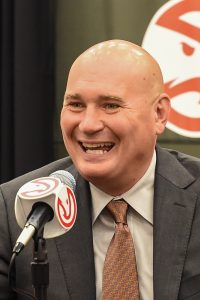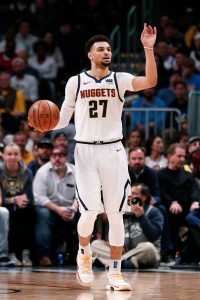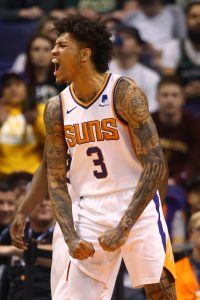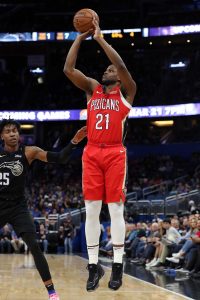After a flurry of activity during the first 10 days of an especially active 2019 free agent period, only a small handful of teams around the NBA still have any meaningful cap room available.
According to Jeff Siegel’s data at Early Bird Rights and Bobby Marks’ numbers at ESPN, the Knicks, Mavericks, Hawks, Pacers, and Clippers are the only clubs that project to have more than $2MM in leftover cap space.
Here’s a look at those five teams that still project to have a bit more room remaining:
New York Knicks
The Knicks had seemingly exhausted nearly all their cap room based on their reported agreements with free agents. However, one of those deals – Reggie Bullock‘s two-year, $21MM pact – is no longer in place after an issue arose with Bullock’s physical. It sounds like the two sides still plan to work something out, but for now, the team has regained enough flexibility to reportedly offer Marcus Morris $15MM for one year.
The Knicks’ precise cap room projection will depend on how they structured all the deals they finalized earlier this week, but Marks lists them at $15.5MM for now. That space would go away if Morris reneges on his deal with the Spurs and heads to New York. If not, the Knicks will have more cap flexibility than any other team, at least until they reach a new deal with Bullock.
Dallas Mavericks
According to Siegel’s numbers (and my own math), the Mavericks can get up as high as about $14.61MM in cap room. However, there’s no guarantee that Dallas even intends to function as an over-the-cap team this offseason.
So far, the Mavs have acquired Delon Wright via sign-and-trade, agreed to deals with free agents Seth Curry and Boban Marjanovic, and come to terms on new contracts for three of their own players (Kristaps Porzingis, Maxi Kleber, and Dorian Finney-Smith). Only the Wright acquisition is official.
If the Mavs wanted to, they could use cap room to acquire Wright and sign Curry, retain the cap holds for their own free agents, and hold off on the Marjanovic signing — that would create $14.61MM in cap room. Once that room is used, Dallas could go over the cap to lock up Porzingis, Kleber, and Finney-Smith, and then sign Boban using the room exception.
However, Dallas has another potential path — stay over the cap by taking Wright’s contract into a preexisting $21MM+ trade exception created in February’s Harrison Barnes deal, sign Curry using the mid-level exception, sign Marjanovic using the bi-annual exception, and re-sign their own free agents using their Bird or Early Bird rights.
In that scenario, the Mavs would forfeit any potential cap room, but would retain about $12MM of that Barnes trade exception, which could be used at anytime up until February 7, 2020.
Trade exceptions aren’t as versatile as cap room, since they can’t be used to sign free agents outright. However, the trade exception’s shelf life would be longer. If Dallas doesn’t find a way to use cap room now, the team would lose it once it makes its agreements with Porzingis, Kleber, and Finney-Smith official. Those players’ cap holds only account for just over $20MM for now, but their combined first-year salaries are expected to total closer to $40MM.
My best guess is that the Mavs used the Barnes trade exception to acquire Wright, and are now actively exploring the free agent and trade markets to assess whether it makes more sense to dip below the cap or to remain above it.
Atlanta Hawks
The Hawks‘ situation is pretty simple. Once the signing of Jabari Parker is official, Atlanta will have a team salary in the $103-104MM range, giving the club between $5-6MM in cap room to work with. That figure come in at about $5.8MM if Parker’s deal has a standard 5% raise from year one to year two, per Siegel.
The Hawks could create up to $7.2MM in space if they waive Jaylen Adams‘ non-guaranteed contract. It’s not clear yet what their plans are for that remaining space though.
Indiana Pacers
The Pacers‘ projection will hinge on how they intend to sign T.J. McConnell. McConnell’s two-year, $7MM deal, which isn’t yet official, could be completed using the room exception. That would leave the Pacers with about $4.82MM in cap room available right now, which would need to be used before the team finalizes its agreements with McConnell and Edmond Sumner.
If the club simply finalizes those McConnell and Sumner contracts and eats up its remaining cap room, it would still have the full $4.77MM room exception at its disposal.
Los Angeles Clippers
Like the Mavericks, the Clippers have agreed to a series of deals that they’ve yet to make official. That’s probably because they’re trying to determine if they can do anything with their remaining space (up to approximately $3.59MM).
That projection accounts for cap holds for Patrick Beverley, Ivica Zubac, and Rodney McGruder, all of whom will be re-signed. It also takes into account Kawhi Leonard‘s maximum-salary contract, and Danilo Gallinari‘s and Shai Gilgeous-Alexander‘s cap hits, since trading them for Paul George figures to be one of the last moves the Clippers make.
Our Clippers’ projection was at about $4.49MM before the team officially signed second-round pick Terance Mann on Tuesday, adding his cap hit to the books — we’re assuming that contract will start at the rookie minimum, but L.A. had the room to give him more.
Once the Clippers determine what they’ll do with their remaining cap space and officially use it up, they’ll be able to move forward on all those deals, including signing JaMychal Green using the room exception.
 The Hawks‘ inactivity on the free agent market so far is unsurprising. When he looked ahead to the free agent period
The Hawks‘ inactivity on the free agent market so far is unsurprising. When he looked ahead to the free agent period 

